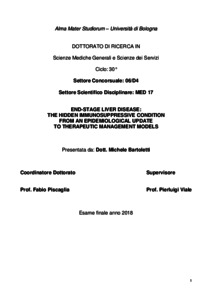Bartoletti, Michele
(2018)
End-stage liver disease: the hidden immunosuppressive condition. From an epidemiological update to therapeutic management models, [Dissertation thesis], Alma Mater Studiorum Università di Bologna.
Dottorato di ricerca in
Scienze mediche generali e scienze dei servizi, 30 Ciclo. DOI 10.6092/unibo/amsdottorato/8277.
Documenti full-text disponibili:
![[img]](http://amsdottorato.unibo.it/8277/1.hassmallThumbnailVersion/Bartoletti_Michele_Tesi.pdf)  Anteprima |
|
Documento PDF (English)
- Richiede un lettore di PDF come Xpdf o Adobe Acrobat Reader
Disponibile con Licenza: Salvo eventuali più ampie autorizzazioni dell'autore, la tesi può essere liberamente consultata e può essere effettuato il salvataggio e la stampa di una copia per fini strettamente personali di studio, di ricerca e di insegnamento, con espresso divieto di qualunque utilizzo direttamente o indirettamente commerciale. Ogni altro diritto sul materiale è riservato.
Download (1MB)
| Anteprima
|
Abstract
The objective of this work was to describe the current epidemiology, evaluate the short and long-term prognosis and test novel strategies to treat infections in cirrhotic patients
Methods
We conducted four studies using two different cohort of cirrhotic patients collected prospectively and developing bloodstream infections (BSIs) at 19 centers from September-2014 to December-2015 (BICHROME) and all consecutive cirrhotic patients admitted for an episode of acute decompensation from January-2014 to March-2016 at S.Orsola-Malpighi Hospital, Bologna and at the “Infermi” Hospital, Rimini(BIC).
Results
The BICHROME study included 312 patients. Gram-negative bacteria, Gram-positive cocci (GPC) and Candida spp. caused 53%, 47% and 7% of episodes, respectively. At multivariate analysis factors independently associated to GPC isolation were alcoholic cirrhosis (p=0.03), device-related infection (p=0.007), pneumonia (p=0.02), previous hepatorenal syndrome (p=0.03) and diabetes with organ damage (p=0.008)
The 30-day mortality rate was 25% and best predicted by the CLIF-SOFA score (aROC 0.82). In a Cox-regression model, delayed (>24h) antibiotic treatment (p<0.001), inadequate empirical therapy(p<0.001) and CLIF-SOFA(p<0.001) were predictors of 30-day mortality. Among patients receiving adequate treatment with piperacillin-tazobactam or carbapenems, those receiving continuous or extended infusion of such antibiotics showed a significantly lower mortality rate even after adjusting for cofounding factors(p=0.04).
In the BIC study, among the 516 patients enrolled, 32% presented an infection. Multivariate logistic regression showed that MELD-Na (p=0.001), QuickSOFA (p=0.004), bacteremia (p=0.004) and isolation MDR pathogens (p=0.048) were independent predictors of acute-on-chronic liver failure(ACLF). Kaplan-Meyers curves showed that 1-year survival was similar in infected and non-infected patients without ACLF (71% vs 67%,p=0.337). As expected, 1-year survival was worsened by the presence of ACLF.
Conclusion
With this work we explored the current epidemiology of bacterial infection in cirrhotic patients, we identified risk factors for MDR pathogens and for BSI caused by GPC. We also assessed long-term prognosis of infection complicated or non-complicated by ACLF.
Abstract
The objective of this work was to describe the current epidemiology, evaluate the short and long-term prognosis and test novel strategies to treat infections in cirrhotic patients
Methods
We conducted four studies using two different cohort of cirrhotic patients collected prospectively and developing bloodstream infections (BSIs) at 19 centers from September-2014 to December-2015 (BICHROME) and all consecutive cirrhotic patients admitted for an episode of acute decompensation from January-2014 to March-2016 at S.Orsola-Malpighi Hospital, Bologna and at the “Infermi” Hospital, Rimini(BIC).
Results
The BICHROME study included 312 patients. Gram-negative bacteria, Gram-positive cocci (GPC) and Candida spp. caused 53%, 47% and 7% of episodes, respectively. At multivariate analysis factors independently associated to GPC isolation were alcoholic cirrhosis (p=0.03), device-related infection (p=0.007), pneumonia (p=0.02), previous hepatorenal syndrome (p=0.03) and diabetes with organ damage (p=0.008)
The 30-day mortality rate was 25% and best predicted by the CLIF-SOFA score (aROC 0.82). In a Cox-regression model, delayed (>24h) antibiotic treatment (p<0.001), inadequate empirical therapy(p<0.001) and CLIF-SOFA(p<0.001) were predictors of 30-day mortality. Among patients receiving adequate treatment with piperacillin-tazobactam or carbapenems, those receiving continuous or extended infusion of such antibiotics showed a significantly lower mortality rate even after adjusting for cofounding factors(p=0.04).
In the BIC study, among the 516 patients enrolled, 32% presented an infection. Multivariate logistic regression showed that MELD-Na (p=0.001), QuickSOFA (p=0.004), bacteremia (p=0.004) and isolation MDR pathogens (p=0.048) were independent predictors of acute-on-chronic liver failure(ACLF). Kaplan-Meyers curves showed that 1-year survival was similar in infected and non-infected patients without ACLF (71% vs 67%,p=0.337). As expected, 1-year survival was worsened by the presence of ACLF.
Conclusion
With this work we explored the current epidemiology of bacterial infection in cirrhotic patients, we identified risk factors for MDR pathogens and for BSI caused by GPC. We also assessed long-term prognosis of infection complicated or non-complicated by ACLF.
Tipologia del documento
Tesi di dottorato
Autore
Bartoletti, Michele
Supervisore
Dottorato di ricerca
Ciclo
30
Coordinatore
Settore disciplinare
Settore concorsuale
Parole chiave
Liver Cirrhosis, bacterial infections, fungal infections, acute-on-chronic liver failure, CLIF-SOFA, multidrug-resistant pathogens
URN:NBN
DOI
10.6092/unibo/amsdottorato/8277
Data di discussione
20 Aprile 2018
URI
Altri metadati
Tipologia del documento
Tesi di dottorato
Autore
Bartoletti, Michele
Supervisore
Dottorato di ricerca
Ciclo
30
Coordinatore
Settore disciplinare
Settore concorsuale
Parole chiave
Liver Cirrhosis, bacterial infections, fungal infections, acute-on-chronic liver failure, CLIF-SOFA, multidrug-resistant pathogens
URN:NBN
DOI
10.6092/unibo/amsdottorato/8277
Data di discussione
20 Aprile 2018
URI
Statistica sui download
Gestione del documento:


 Login
Login
